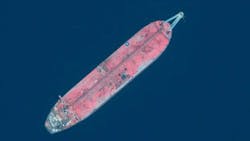Work on decaying FSO Safer expected to begin in next few weeks
Offshore staff
YEMEN — The salvage of the aging supertanker FSO Safer, off the Yemen coast, can now begin, the UN said in late September, after it announced that more than $75 million has been pledged to carry out the operation.
"Moored off Yemen’s Red Sea coast, the FSO Safer is an aging supertanker in advanced state of decay that will soon break apart or explode if the world does not act," the UN website states on its "Stop Red Sea Spill" campaign page.
The vessel's structure has been left exposed to humidity and corrosion with little or no maintenance since Yemen's civil war started in 2015. And in the last few years various companies, countries, media agencies and environmental groups have called the tanker a "ticking time bomb," "massive floating bomb" and a "deadly ghost ship."
The UN's plan to prevent this potential oil spill (by transferring the oil to a safe vessel) was previously delayed because of insufficient funding. The UN began asking for contributions from members of the public in June, and the UN crowdfunding campaign raised the $75 million required for the emergency operation.
In late September, UN and Dutch officials reported that, "Dutch company Smit Salvage is expected to start work within weeks to lift 1.14 MMbbl of oil from the decaying ship. The Boskalis-owned salvage company has been lined up to stabilize the 407,000-dwt FSO Safer in a four-month operation to prepare for the oil to be removed."
More recently, according to the Oct. 3 Maritime Security Threat Advisory report, work on the decaying FSO Safer is expected to begin in the next few weeks.
Phase 2
Once the pledges are fully converted into cash for the initial salvage operation, with more than $77 million promised from 17 countries, another $30 million to $38 million is still needed for Phase 2, which will cover the installation of safe replacement capacity to secure the 1 MMbbl of oil on board.
The UN plan is for this to be done through transferring the oil to a secure double-hulled vessel, as a permanent storage solution, until the political situation allows it to be sold or transported elsewhere.
The UN campaign website says," The FSO Safer vessel is holding four times the amount of oil spilled by the Exxon Valdez—enough to make it the fifth largest oil spill from a tanker in history. If we do not act now, the result will be an environmental and humanitarian catastrophe centered on the coast of a country already devasted by seven years of war. A massive spill from the Safer would destroy pristine reefs, coastal mangroves and other sea life across the Red Sea, expose millions of people to highly polluted air, and cut off food, fuel and other life-saving supplies to Yemen, where 17 million people already need food aid.
"Coastal communities would be hit hardest. Hundreds of thousands of jobs in the fishing industry would be lost almost overnight. It would take 25 years for fish stocks to recover. The cost of cleanup alone would be $20 billion."
History
Safer was built in 1976 by the Hitachi Zosen Corp. in Japan as the oil tanker Esso Japan.
In 1987 Esso Japan was converted into an unpropelled storage vessel and renamed Safer. She was moored about 7 km (4.3 miles) off the coast of Yemen in 1988 under the ownership of the Yemeni government via the national oil company, which used her to store and export oil from inland oil fields around Ma'rib.
In her storage configuration, Safer has a capacity of about 3 MMbbl of oil.
10.04.2022

